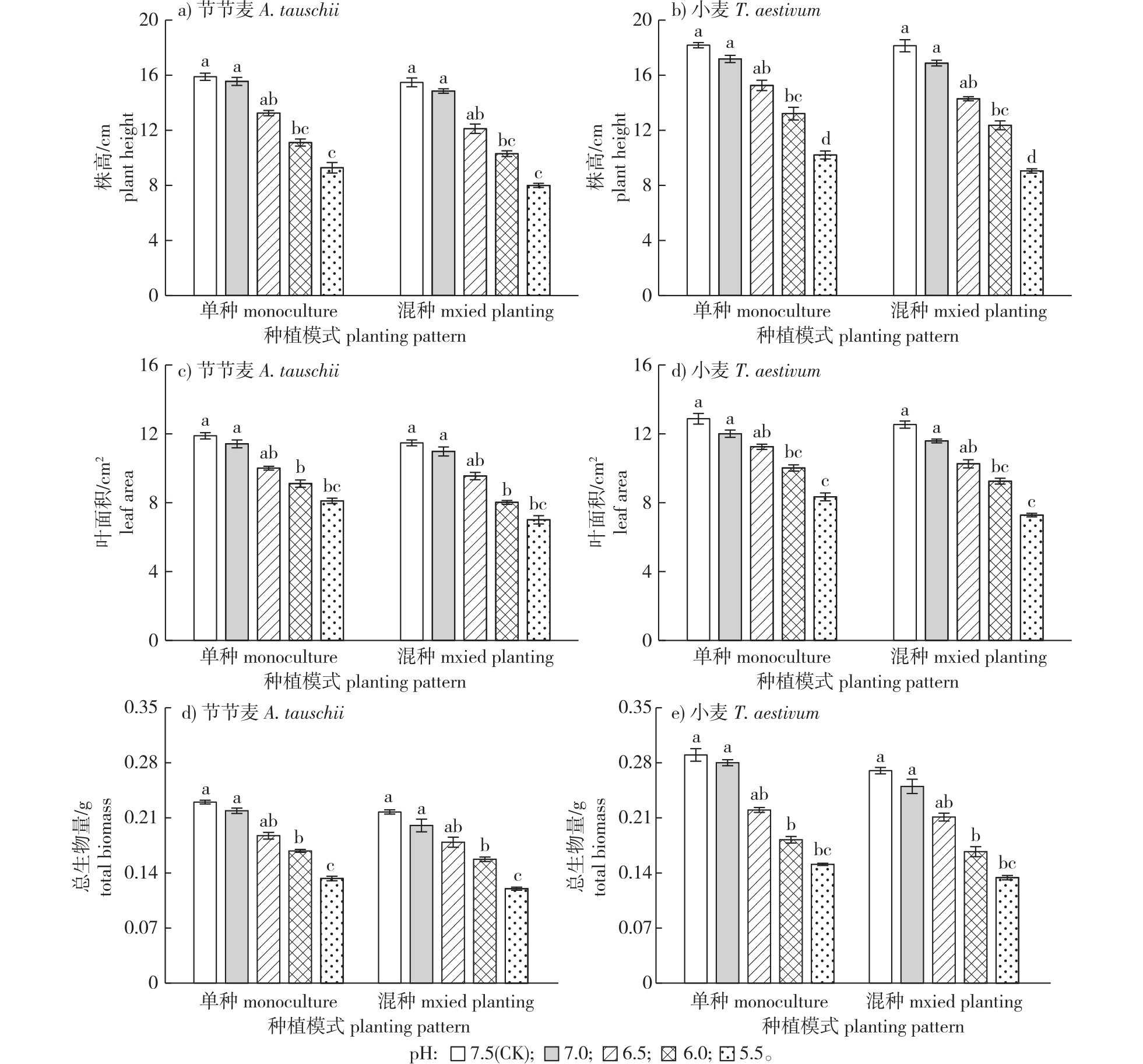 PDF(1856 KB)
PDF(1856 KB)


Effect of soil pH on the growth and competitiveness of invasive plant Aegilops tauschii
WANG Ning, YUAN Meili, HUANG Zixuan, LIU Chang, ZHANG Xiaoyuan, TIAN Yaowu
Journal of Nanjing Forestry University (Natural Sciences Edition) ›› 2025, Vol. 49 ›› Issue (5) : 87-94.
 PDF(1856 KB)
PDF(1856 KB)
 PDF(1856 KB)
PDF(1856 KB)
Effect of soil pH on the growth and competitiveness of invasive plant Aegilops tauschii
【Objective】 Aegilops tauschii, has emerged as one of the most detrimental weed threatening winter wheat (Triticum aestivum) production systems across China. This study investigates the morphological and physiological adaptation mechanisms of A. tauschii under soil acidification stress, aiming to establish a scientific foundation for early warning systems and ecological management strategies against its invasive expansion.【Method】A controlled pot experiment was conducted using de Wit’s replacement series design to systematically compare seedling morphological characteristics, physiological-biochemical responses, and interspecific competitiveness between A. tauschii and wheat. Five soil pH gradients (7.5, 7.0, 6.5, 6.0, 5.5) and two planting patterns (monoculture and mixed planting) were established. 【Result】(1) Two-way ANOVA analysis revealed that different soil pH levels significantly affected seedling height, leaf area, and total biomass. (2) As soil pH decreased, seedling height, leaf area, and total biomass also decreased, indicating inhibited growth. However, when the pH decreased to 5.5, the reductions in seedling height, leaf area, and total biomass were significantly lower in A. tauschii than in wheat, suggesting a superior adaptation capacity of A. tauschii to low pH. (3) As pH decreased, superoxide dismutase (SOD) activity and proline content tended to increase. However, with a further decrease in pH (pH 6.0-5.5), relative electrical conductivity and thiobarbituric acid reactive substances (TBARS) content significantly increased, potentially due to exacerbated cell membrane damage at low pH. (4) Competitive indices (relative yield, relative yield total, and competition coefficient) indicated that A. tauschii consistently exhibited higher competitive abilities than wheat across all pH conditions. The competition coefficient (CB) of A. tauschii initially increased and then decreased with declining pH. 【Conclusion】A. tauschii demonstrates a capacity to adapt to decreasing soil pH through adjustments in morphological structure, biomass allocation patterns, and physiological characteristics. Within the experimental pH range (5.5-7.5), its stress resistance and competitive ability consistently exceeded that those of wheat.

soil pH / Aegilops tauschii / competitive balance / wheat(Triticum aestivum)
| [1] |
|
| [2] |
|
| [3] |
|
| [4] |
|
| [5] |
|
| [6] |
|
| [7] |
|
| [8] |
|
| [9] |
|
| [10] |
|
| [11] |
|
| [12] |
|
| [13] |
房锋. 节节麦(Aegilops tauschii Coss.)生态适应性[D]. 北京: 中国农业科学院, 2012.
|
| [14] |
张朝贤, 李香菊, 黄红娟, 等. 警惕麦田恶性杂草节节麦蔓延危害[J]. 植物保护学报, 2007, 34(1):103-106.
|
| [15] |
强胜, 张欢. 中国农业生态系统外来植物入侵及其管理现状[J]. 南京农业大学学报, 2022, 45(5):957-980.
|
| [16] |
高兴祥, 张悦丽, 李美, 等. 节节麦等三种禾本科杂草对不同性状土壤的适应性[J]. 植物保护学报, 2019, 46(4):832-839.
|
| [17] |
|
| [18] |
|
| [19] |
|
| [20] |
张宗祥, 黄峥嵘, 吴雪凡, 等. 土壤酸化对玉米产量、氮代谢及相关基因表达的影响[J]. 华北农学报, 2022, 37(3):94-103.
|
| [21] |
|
| [22] |
肖强, 叶文景, 朱珠, 等. 利用数码相机和Photoshop软件非破坏性测定叶面积的简便方法[J]. 生态学杂志, 2005, 24(6):711-714.
|
| [23] |
李合生. 植物生理生化实验原理及技术[M]. 北京: 高等教育出版社, 2000.
|
| [24] |
邹琦. 植物生理生化实验指导[M]. 北京: 中国农业出版社, 2003.
|
| [25] |
|
| [26] |
|
| [27] |
|
| [28] |
|
| [29] |
戴学斌, 许瑜兴, 邓义, 等. 土壤酸胁迫对黑麦草生长生理及镉富集特征的影响[J]. 水土保持研究, 2021, 28(6):389-396.
|
| [30] |
童贯和, 程滨, 胡云虎. 模拟酸雨及其酸化土壤对小麦幼苗生物量和某生理活动的影响[J]. 作物学报, 2005, 31(9):1207-1214.
|
| [31] |
|
| [32] |
王宁, 袁美丽, 王磊, 等. 入侵植物节节麦表型可塑性及竞争能力对模拟氮沉降的响应[J]. 草地学报, 2018, 26(6): 1428-1434.
|
| [33] |
路亚, 王春晓, 王丽丽, 等. 花生幼苗对酸胁迫的生理响应及品种间差异[J]. 华北农学报, 2020, 35(1):73-80.
|
| [34] |
|
| [35] |
|
| [36] |
|
| [37] |
|
| [38] |
|
| [39] |
李智燕, 邢学峰, 唐华, 等. 铝和酸胁迫对苜蓿根瘤菌生长和抗氧化酶系的影响[J]. 草业学报, 2013, 22(3):146-153.
|
| [40] |
|
| [41] |
|
| [42] |
|
| [43] |
|
| [44] |
|
| [45] |
|
| [46] |
|
| [47] |
|
| [48] |
|
| [49] |
|
/
| 〈 |
|
〉 |